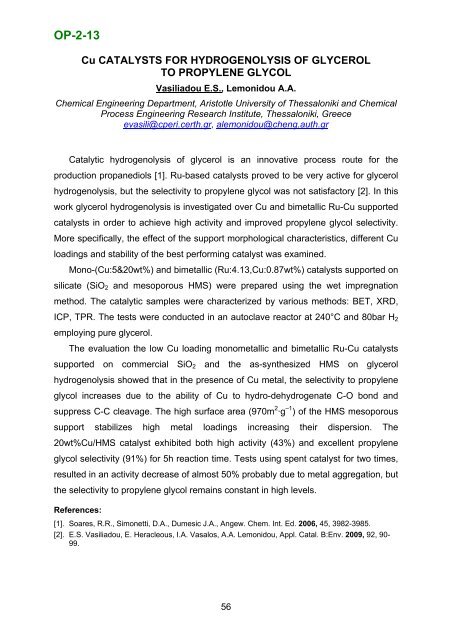Boreskov Institute of Catalysis SB RAS, Novosibirsk, Russia
Boreskov Institute of Catalysis SB RAS, Novosibirsk, Russia
Boreskov Institute of Catalysis SB RAS, Novosibirsk, Russia
- No tags were found...
You also want an ePaper? Increase the reach of your titles
YUMPU automatically turns print PDFs into web optimized ePapers that Google loves.
OP-2-13Cu CATALYSTS FOR HYDROGENOLYSIS OF GLYCEROLTO PROPYLENE GLYCOLVasiliadou E.S., Lemonidou A.A.Chemical Engineering Department, Aristotle University <strong>of</strong> Thessaloniki and ChemicalProcess Engineering Research <strong>Institute</strong>, Thessaloniki, Greeceevasili@cperi.certh.gr, alemonidou@cheng.auth.grCatalytic hydrogenolysis <strong>of</strong> glycerol is an innovative process route for theproduction propanediols [1]. Ru-based catalysts proved to be very active for glycerolhydrogenolysis, but the selectivity to propylene glycol was not satisfactory [2]. In thiswork glycerol hydrogenolysis is investigated over Cu and bimetallic Ru-Cu supportedcatalysts in order to achieve high activity and improved propylene glycol selectivity.More specifically, the effect <strong>of</strong> the support morphological characteristics, different Culoadings and stability <strong>of</strong> the best performing catalyst was examined.Mono-(Cu:5&20wt%) and bimetallic (Ru:4.13,Cu:0.87wt%) catalysts supported onsilicate (SiO 2 and mesoporous HMS) were prepared using the wet impregnationmethod. The catalytic samples were characterized by various methods: BET, XRD,ICP, TPR. The tests were conducted in an autoclave reactor at 240°C and 80bar H 2employing pure glycerol.The evaluation the low Cu loading monometallic and bimetallic Ru-Cu catalystssupported on commercial SiO 2 and the as-synthesized HMS on glycerolhydrogenolysis showed that in the presence <strong>of</strong> Cu metal, the selectivity to propyleneglycol increases due to the ability <strong>of</strong> Cu to hydro-dehydrogenate C-O bond andsuppress C-C cleavage. The high surface area (970m 2·g –1 ) <strong>of</strong> the HMS mesoporoussupport stabilizes high metal loadings increasing their dispersion. The20wt%Cu/HMS catalyst exhibited both high activity (43%) and excellent propyleneglycol selectivity (91%) for 5h reaction time. Tests using spent catalyst for two times,resulted in an activity decrease <strong>of</strong> almost 50% probably due to metal aggregation, butthe selectivity to propylene glycol remains constant in high levels.References:[1]. Soares, R.R., Simonetti, D.A., Dumesic J.A., Angew. Chem. Int. Ed. 2006, 45, 3982-3985.[2]. E.S. Vasiliadou, E. Heracleous, I.A. Vasalos, A.A. Lemonidou, Appl. Catal. B:Env. 2009, 92, 90-99.56
















